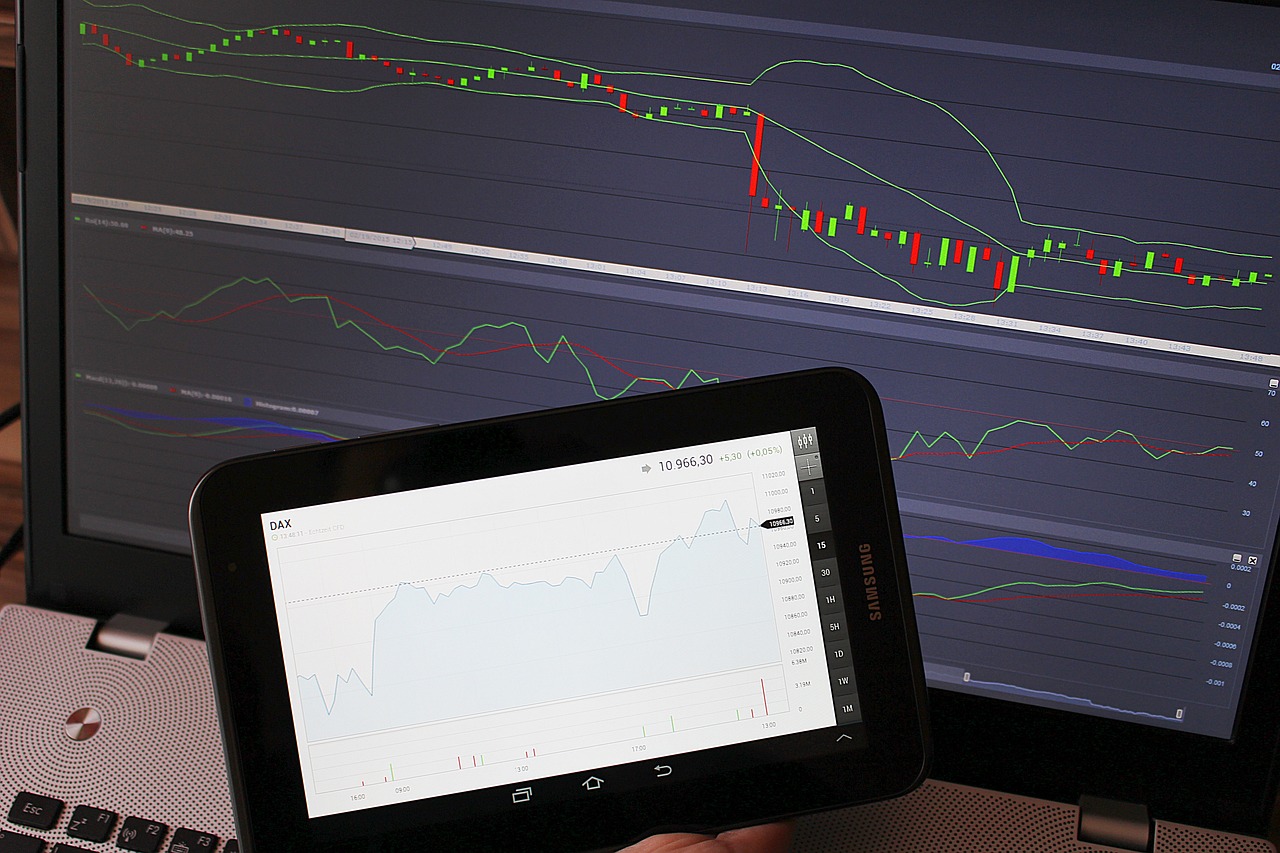Understanding the Role of Whale Activity in Market Trends
Have you ever wondered how a single decision by a large investor can ripple through the financial markets, causing a wave of price changes and market sentiments? This phenomenon is often attributed to what we call "whales." In the world of finance, whales are individuals or entities that hold substantial amounts of assets, whether in stocks, cryptocurrencies, or other financial instruments. Their trading decisions are not just significant; they are often pivotal, capable of influencing market trends and creating a domino effect that affects countless smaller investors. Understanding the role of these whales is crucial for anyone looking to navigate the sometimes turbulent waters of financial markets.
Picture a whale swimming through the ocean. Its sheer size and power can create massive waves, altering the environment around it. Similarly, when a whale makes a move in the market—whether it be buying or selling large quantities of assets—it can create sharp price fluctuations that smaller investors must contend with. This article delves into the intricate relationship between whale activity and market dynamics, shedding light on how these large players can shape financial landscapes.
Whales are not just your average investors; they are the heavyweights of the financial world. These entities can range from hedge funds and institutional investors to wealthy individuals with deep pockets. Their ability to buy or sell large volumes of assets can lead to substantial price shifts, making their activities crucial for understanding market dynamics. For instance, when a whale decides to sell a significant portion of their holdings, it can trigger a sell-off among retail investors, leading to a rapid decline in asset prices. Conversely, a large purchase can create a sense of optimism, driving prices up as other investors jump on the bandwagon.
The impact of whale trading on market volatility cannot be overstated. The sheer size of their transactions can create sharp fluctuations in prices, often leading to panic or euphoria among smaller investors. This volatility is particularly pronounced in markets that are less liquid, where a single large transaction can have an outsized impact. Understanding these dynamics is essential for investors looking to navigate uncertain market conditions more effectively.
Whale trading can create sharp price fluctuations. Understanding how their buying and selling patterns affect volatility can help investors navigate uncertain market conditions more effectively. For example, if a whale suddenly decides to offload a significant portion of their assets, it could lead to a rapid decline in prices, causing a panic sell-off among retail investors. On the other hand, if a whale makes a substantial purchase, it can instill confidence in the market, prompting others to follow suit.
Recognizing whale activity involves tracking large transactions and market movements. Tools and indicators can assist traders in spotting these influential players and predicting potential market impacts. For instance, platforms that offer real-time data on large trades can help investors stay ahead of the curve. By keeping an eye on these transactions, traders can gain insights into the behavior of whales and make more informed decisions.
In cryptocurrency markets, blockchain analysis provides insights into whale transactions. By monitoring wallet addresses, investors can gauge whale behavior and anticipate market shifts. This transparency allows smaller investors to understand the movements of large players and adjust their strategies accordingly. The ability to track these transactions in real-time can be a game-changer for those looking to capitalize on market trends.
Several platforms offer whale alert services that notify users of significant trades. These tools can help traders stay informed about potential market-moving events. By subscribing to these alerts, investors can be proactive rather than reactive, positioning themselves to take advantage of price movements caused by whale activity.
There is often a strong correlation between whale activity and price trends. Analyzing historical data can reveal patterns that traders can leverage for strategic decision-making. For example, if a whale consistently buys during a price dip, it may indicate a bullish sentiment that smaller investors can capitalize on. Conversely, if a whale frequently sells during price surges, it could signal a bearish outlook that others might want to heed.
Whale sentiment plays a crucial role in market psychology. Their confidence or fear can influence retail investor behavior, leading to broader market trends. If whales are bullish, it often creates a sense of optimism in the market, leading to increased buying activity among smaller investors. On the flip side, if whales appear to be offloading their assets, it can instill fear, triggering panic selling.
Studying the behavioral patterns of whales can provide insights into their market strategies. Understanding these patterns can help smaller investors align their strategies accordingly. For instance, if a particular whale has a history of buying during market corrections, it may be wise for smaller investors to consider similar strategies during downturns. Analyzing these behaviors can lead to better decision-making and improved investment outcomes.
Analyzing specific case studies where whale activity significantly impacted market trends can offer valuable lessons. These examples illustrate the potential consequences of whale movements on prices. For instance, during the 2020 Bitcoin bull run, several large purchases by known whales led to substantial price increases, creating a frenzy of buying among retail investors. Understanding these case studies can provide insights into the mechanics of whale influence and help investors anticipate future market movements.
Retail investors can adopt strategies to mitigate risks associated with whale activity. Learning to interpret whale movements can enhance decision-making and improve investment outcomes. Here are some strategies to consider:
- Monitor whale alerts to stay informed about significant trades.
- Analyze historical data to identify patterns in whale behavior.
- Consider the sentiment of whales when making investment decisions.
What are whales in financial markets?
Whales are large investors or entities that hold significant amounts of assets. Their trading decisions can lead to substantial price shifts.
How can I track whale activity?
You can track whale activity by using monitoring tools and platforms that provide real-time data on large transactions.
Why is whale sentiment important?
Whale sentiment can influence retail investor behavior, leading to broader market trends. Understanding their confidence or fear can help smaller investors make informed decisions.
Can retail investors benefit from whale activity?
Yes, by learning to interpret whale movements and adopting strategies accordingly, retail investors can enhance their decision-making and improve investment outcomes.

whales,
This article explores how large investors, often referred to as whales, influence market trends, price movements, and overall market sentiment in various financial arenas.
Whales are individuals or entities that hold significant amounts of assets. Their trading decisions can lead to substantial price shifts, making their activities crucial for understanding market dynamics.
Whale trading can create sharp price fluctuations. Understanding how their buying and selling patterns affect volatility can help investors navigate uncertain market conditions more effectively.
Recognizing whale activity involves tracking large transactions and market movements. Tools and indicators can assist traders in spotting these influential players and predicting potential market impacts.
In cryptocurrency markets, blockchain analysis provides insights into whale transactions. By monitoring wallet addresses, investors can gauge whale behavior and anticipate market shifts.
Several platforms offer whale alert services that notify users of significant trades. These tools can help traders stay informed about potential market-moving events.
There is often a strong correlation between whale activity and price trends. Analyzing historical data can reveal patterns that traders can leverage for strategic decision-making.
Whale sentiment plays a crucial role in market psychology. Their confidence or fear can influence retail investor behavior, leading to broader market trends.
Studying the behavioral patterns of whales can provide insights into their market strategies. Understanding these patterns can help smaller investors align their strategies accordingly.
Analyzing specific case studies where whale activity significantly impacted market trends can offer valuable lessons. These examples illustrate the potential consequences of whale movements on prices.
Retail investors can adopt strategies to mitigate risks associated with whale activity. Learning to interpret whale movements can enhance decision-making and improve investment outcomes.
In the world of finance, the term whales refers to those who possess a massive amount of assets, whether in traditional markets or cryptocurrencies. Imagine a colossal whale gliding through the ocean; its sheer size can create waves that affect everything in its path. Similarly, when these large investors make moves, they can send ripples through the market, impacting prices and investor sentiment. The actions of whales are not just about their own interests; they can sway entire markets, causing smaller investors to react, often leading to increased volatility.
Whales often operate with a level of discretion, making their movements less visible to the average trader. However, their strategies can often be deciphered through careful analysis. For instance, when a whale decides to buy or sell a significant portion of their holdings, the market can react dramatically. This reaction can be likened to a pebble thrown into a pond, where the ripples spread far beyond the initial point of impact.
To understand the influence of whales, one must look at various indicators:
- Transaction Size: Large trades can indicate whale activity.
- Market Sentiment: A sudden price change may reflect a whale's decision.
- Volume Spikes: Unusually high trading volumes often correlate with whale movements.
By monitoring these indicators, traders can gain insights into potential market shifts. For instance, if a whale starts accumulating a particular asset, it may signal confidence in that asset, prompting other investors to follow suit. Conversely, if a whale begins to offload their holdings, it might raise red flags, leading to a sell-off among retail investors.
Q: What defines a whale in financial markets?
A: A whale is typically defined as an individual or entity that holds a large amount of assets, significantly influencing market trends through their trading activities.
Q: How can I track whale activity?
A: Whale activity can be tracked using various tools and platforms that monitor large transactions and market movements. Blockchain analysis is particularly useful in cryptocurrency markets.
Q: What impact do whales have on market volatility?
A: Whales can create sharp price fluctuations through their trading decisions, leading to increased market volatility that can affect all investors.
Q: How can retail investors protect themselves from whale movements?
A: Retail investors can mitigate risks by learning to interpret whale movements and using them to inform their trading strategies.

influence market trends, price movements, and overall market sentiment in various financial arenas.
This article explores how large investors, often referred to as whales, influence market trends, price movements, and overall market sentiment in various financial arenas.
Whales are individuals or entities that hold significant amounts of assets. Their trading decisions can lead to substantial price shifts, making their activities crucial for understanding market dynamics.
Whale trading can create sharp price fluctuations. Understanding how their buying and selling patterns affect volatility can help investors navigate uncertain market conditions more effectively.
Recognizing whale activity involves tracking large transactions and market movements. Tools and indicators can assist traders in spotting these influential players and predicting potential market impacts.
In cryptocurrency markets, blockchain analysis provides insights into whale transactions. By monitoring wallet addresses, investors can gauge whale behavior and anticipate market shifts.
Several platforms offer whale alert services that notify users of significant trades. These tools can help traders stay informed about potential market-moving events.
There is often a strong correlation between whale activity and price trends. Analyzing historical data can reveal patterns that traders can leverage for strategic decision-making.
Whale sentiment plays a crucial role in market psychology. Their confidence or fear can influence retail investor behavior, leading to broader market trends.
Studying the behavioral patterns of whales can provide insights into their market strategies. Understanding these patterns can help smaller investors align their strategies accordingly.
Analyzing specific case studies where whale activity significantly impacted market trends can offer valuable lessons. These examples illustrate the potential consequences of whale movements on prices.
Retail investors can adopt strategies to mitigate risks associated with whale activity. Learning to interpret whale movements can enhance decision-making and improve investment outcomes.
Whale activity is not just a buzzword; it’s a powerful force that shapes the landscape of financial markets. When a whale decides to buy or sell a substantial amount of an asset, the ripples can be felt across the entire market. This is because their transactions often lead to notable price movements, impacting not only the assets in question but also the overall market sentiment.
For instance, consider a scenario where a whale suddenly sells off a large portion of their cryptocurrency holdings. This action can trigger panic among retail investors, leading to a cascade of sell-offs as they fear a further decline in prices. Conversely, when whales buy large amounts of an asset, it can create a sense of security and optimism, encouraging more investors to enter the market, thus driving prices up. This dance of influence between whales and retail investors can create a volatile environment that is both exciting and risky.
In various financial arenas, such as stocks, commodities, and cryptocurrencies, the impact of whale activity can vary. For example, in the stock market, institutional investors often act as whales. Their decisions can sway market sentiment and lead to significant price changes. In contrast, in the cryptocurrency market, the anonymity and decentralization can make whale movements even more unpredictable and dramatic.
To illustrate this further, let’s take a look at a simple table that summarizes how whale activity influences different financial markets:
| Financial Market | Whale Activity Impact |
|---|---|
| Stock Market | Institutional trades can lead to major price shifts and influence overall market sentiment. |
| Cryptocurrency Market | Large transactions can cause sudden price drops or spikes, affecting retail investor behavior. |
| Commodities Market | Whale movements can signal trends in supply and demand, impacting prices significantly. |
In summary, understanding the influence of whale activity is vital for anyone looking to navigate the complexities of financial markets. By keeping an eye on these large players, investors can better anticipate market movements and make more informed decisions. After all, in the world of finance, knowledge is power, and being aware of whale activities can give you the edge you need.
- What are whales in financial markets?
Whales are individuals or entities that hold large amounts of assets, significantly impacting market trends and price movements. - How can I identify whale activity?
Whale activity can be identified by tracking large transactions and utilizing tools that monitor significant market movements. - Why is whale sentiment important?
Whale sentiment can influence retail investor behavior, often leading to broader market trends based on their confidence or fear. - Are there tools to track whale transactions?
Yes, various platforms offer whale alert services that notify users of significant trades and help monitor whale activities.

The Concept of Whales in Financial Markets
When we talk about whales in financial markets, we're not referring to the majestic creatures of the ocean, but rather to the colossal players that hold significant amounts of assets. These entities can be individuals, hedge funds, or institutional investors who possess the power to sway market trends with their trading activities. Imagine a massive ship navigating through a sea of smaller boats; the ship's movements can create waves that impact everything around it. Similarly, the trading decisions made by whales can lead to substantial price shifts, making their activities crucial for understanding market dynamics.
Whales typically hold a large percentage of the total supply of a given asset, which means their buying or selling decisions can cause noticeable fluctuations in prices. For example, if a whale decides to sell a large portion of their holdings, it could trigger a wave of panic among smaller investors, leading to a rapid decline in prices. Conversely, if they make a significant purchase, it could instill confidence in the market, causing prices to surge. This phenomenon is not limited to stocks; it extends to cryptocurrencies and commodities as well, highlighting the pervasive influence of these financial giants.
To put this into perspective, let's consider the following table that outlines the characteristics of whales:
| Characteristic | Description |
|---|---|
| Asset Holding | Whales possess a large volume of assets, often making up a significant percentage of the total supply. |
| Market Influence | Their buying and selling activities can lead to sharp price movements, affecting overall market sentiment. |
| Trading Strategies | Whales often employ sophisticated trading strategies that can be difficult for retail investors to replicate. |
| Market Sentiment | Their actions can create psychological impacts on retail investors, influencing market trends. |
Understanding the concept of whales is essential for any investor looking to navigate the complexities of the financial markets. Recognizing their potential impact can help smaller investors make more informed decisions. It’s like being a sailor who learns to read the tides and winds; knowing when a whale is in the water can give you a significant advantage.
Moreover, the presence of whales can lead to increased market volatility. Their trades are often large enough to disrupt the normal flow of supply and demand, causing prices to swing dramatically. This volatility can be both a risk and an opportunity for traders. While it may lead to losses if one is caught on the wrong side of a whale's trade, it can also present lucrative opportunities for those who can anticipate these movements.
In conclusion, whales are not just big players in the financial markets—they are pivotal forces that can shape market dynamics. By understanding their role and influence, retail investors can better position themselves to ride the waves created by these market giants.

Impact of Whale Trading on Market Volatility
Whale trading significantly impacts market volatility, often causing sharp price fluctuations that can leave even seasoned investors reeling. Imagine the market as a vast ocean, where these whales are the massive ships that can create waves with their movements. When a whale decides to buy or sell a significant amount of an asset, it can send ripples throughout the market, affecting prices and investor sentiment. This phenomenon can lead to a cascade of reactions, where smaller investors might panic and either sell off their assets or jump in to ride the wave, further exacerbating the volatility.
Understanding the mechanics of whale trading is crucial for anyone looking to navigate these turbulent waters. When whales make large purchases, it often signals confidence in the asset, potentially attracting other investors. Conversely, when they sell off their holdings, it can induce fear and uncertainty, prompting a sell-off among retail investors. This interplay creates a feedback loop where whale actions directly influence market behavior, leading to increased volatility.
To illustrate this impact, let’s take a look at a hypothetical example:
| Whale Action | Market Response | Price Movement |
|---|---|---|
| Whale buys 10,000 BTC | Increased buying interest from retail investors | Price rises by 15% |
| Whale sells 10,000 BTC | Panic selling among retail investors | Price drops by 20% |
This table highlights how a single whale action can lead to significant price changes, showcasing the direct correlation between whale trading and market volatility. It's essential for investors to keep a close eye on whale activities, as these movements can provide valuable insights into potential market trends.
Moreover, the volatility induced by whale trading can create both risks and opportunities. For instance, savvy traders might capitalize on the price swings caused by whale movements, buying low during a sell-off and selling high when the price rebounds. However, this strategy requires a deep understanding of market dynamics and a keen eye for timing, as the actions of whales can be unpredictable.
In conclusion, whale trading plays a pivotal role in shaping market volatility. By understanding how these large investors operate, retail investors can better prepare themselves for the ups and downs of the market. Monitoring whale activities and analyzing their potential impacts can be the key to navigating through the often choppy waters of financial trading.
- What are whales in financial markets? Whales are individuals or entities that hold large amounts of assets, and their trading decisions can significantly influence market trends.
- How can I identify whale activity? Whale activity can be identified by tracking large transactions and using monitoring tools that alert you of significant trades.
- What tools can help track whale trading? Blockchain analysis tools and whale alert services can provide insights into whale transactions and market movements.
- How does whale trading affect retail investors? Whale trading can create volatility, which may lead to panic selling or buying among retail investors, impacting their investment outcomes.

Identifying Whale Activity
Identifying whale activity is crucial for any investor looking to navigate the turbulent waters of financial markets. But how do you even spot these market giants? Well, it all starts with understanding the sheer scale of their transactions. Whales are known for making significant trades that can move entire markets, and their buying or selling patterns can often be tracked through various indicators and tools. By keeping an eye on these large transactions, investors can gain insights into potential market shifts before they happen.
One of the most effective methods for identifying whale activity is through blockchain analysis, especially in the realm of cryptocurrencies. This involves monitoring specific wallet addresses that are known to belong to whales. By analyzing the flow of assets into and out of these wallets, investors can gauge the sentiment and potential future actions of these influential players. For instance, if a whale suddenly starts accumulating large amounts of a particular cryptocurrency, it could signal a bullish trend, while significant sell-offs might indicate bearish sentiment.
Moreover, there are several platforms and tools available that provide real-time alerts for whale transactions. These whale alert services notify users of significant trades, allowing traders to react quickly to potential market-moving events. By utilizing these tools, you can stay one step ahead and make informed decisions based on the actions of these large investors. It's like having a radar that picks up on the movements of the biggest fish in the sea, giving you a clearer picture of the market landscape.
In addition to tracking transactions, you can also look at other indicators such as trading volume and market depth. A sudden spike in trading volume can often suggest whale activity, as these large investors tend to execute trades that are much larger than the average retail investor. Similarly, observing the order book can reveal large buy or sell orders, which may indicate that a whale is positioning themselves for a significant move.
Ultimately, the key to successfully identifying whale activity lies in combining various analytical approaches. By using a mix of blockchain analysis, trading volume observations, and real-time alert systems, you can create a comprehensive strategy to monitor these influential players. Remember, understanding whale movements is not just about tracking their trades; it's about interpreting the underlying sentiment and potential market implications that come with those trades.
- What are whales in financial markets? Whales are individuals or entities that hold large amounts of assets, and their trading decisions can significantly impact market trends.
- How can I track whale activity? You can track whale activity by monitoring large transactions, using blockchain analysis, and utilizing whale alert services.
- Why is whale activity important for retail investors? Understanding whale activity can help retail investors anticipate market movements and make more informed trading decisions.
- What tools can help identify whale activity? Tools like blockchain explorers, trading volume analytics, and whale alert platforms can assist in identifying whale activity.

Blockchain Analysis for Whale Tracking
In the ever-evolving landscape of financial markets, particularly in the realm of cryptocurrencies, blockchain analysis serves as a powerful tool for tracking whale activity. Whales, defined as individuals or entities holding large amounts of assets, can significantly influence market trends. By leveraging blockchain technology, investors can gain insights into whale transactions, allowing them to make more informed decisions. This process involves examining the public ledger that records all transactions, enabling analysts to identify large movements of assets that could indicate potential market shifts.
One of the primary benefits of blockchain analysis is its transparency. Unlike traditional financial markets, where transactions can be opaque, blockchain provides a clear view of asset flows. By monitoring specific wallet addresses known to belong to whales, traders can observe their buying and selling patterns. For instance, if a whale suddenly transfers a substantial amount of cryptocurrency from one wallet to another, it may signal an impending sale that could lead to price declines. Conversely, large purchases could suggest rising confidence in a particular asset, prompting other investors to jump on the bandwagon.
To effectively utilize blockchain analysis for whale tracking, investors often rely on various tools and platforms designed to simplify the process. These tools can aggregate data from multiple blockchains, providing real-time alerts on significant transactions. For example, some platforms offer features that allow users to set thresholds for transaction sizes, notifying them whenever a whale makes a move that exceeds a specific amount. This immediate access to information can be invaluable, as it allows traders to react swiftly to potential market changes.
In addition to individual transactions, blockchain analysis can also reveal broader trends in whale behavior. By examining historical data, analysts can identify patterns that correlate with price movements. For instance, if data shows that whales tend to sell off assets after a prolonged price increase, retail investors might consider adopting a more cautious approach during similar market conditions. Understanding these patterns can provide a strategic advantage, helping smaller investors align their actions with those of larger players in the market.
To illustrate the impact of blockchain analysis on whale tracking, consider the following table summarizing key metrics used in this analysis:
| Metric | Description | Importance |
|---|---|---|
| Transaction Volume | The total amount of cryptocurrency transferred in a transaction. | High transaction volumes can indicate whale activity. |
| Wallet Address Activity | Patterns of transactions from specific wallet addresses. | Identifying known whale addresses helps in tracking their movements. |
| Time of Transactions | The specific timestamps of large transactions. | Timing can reveal market sentiment and potential price movements. |
In conclusion, blockchain analysis is an essential aspect of tracking whale activity in the cryptocurrency markets. By understanding how to interpret blockchain data, investors can better navigate the complexities of market dynamics influenced by these significant players. As the cryptocurrency space continues to grow, mastering the art of whale tracking through blockchain analysis will undoubtedly provide a competitive edge for investors looking to enhance their strategies.
- What is a whale in the context of financial markets?
Whales are individuals or entities that hold a large amount of assets, capable of influencing market trends with their trading decisions. - How does blockchain analysis help in tracking whales?
Blockchain analysis allows investors to monitor large transactions and wallet movements, providing insights into whale behavior and potential market impacts. - Are there tools available for whale tracking?
Yes, there are various platforms and tools that offer whale alert services, notifying users of significant trades and transactions. - Can retail investors benefit from whale tracking?
Absolutely! By understanding whale movements, retail investors can make more informed decisions and align their strategies accordingly.

Whale Alerts and Monitoring Tools
In the fast-paced world of financial markets, staying ahead of the curve is essential, especially when it comes to the activities of whales. These large investors can make waves that ripple through the market, affecting prices and trends in ways that smaller investors often find difficult to predict. This is where come into play, acting as essential resources for traders looking to navigate the sometimes tumultuous waters of asset trading.
Whale alert systems are designed to track significant transactions and movements within the market, providing real-time notifications that can be crucial for making informed trading decisions. Imagine you’re a surfer waiting for the perfect wave; these tools are like your surfboard, helping you ride the market's ebbs and flows. By alerting you to large trades, these systems allow you to react quickly to potential market shifts, giving you a competitive edge.
There are various platforms available that offer whale alert services, each with its own unique features and functionalities. Some of the most popular tools include:
- Whale Alert: This platform tracks large transactions across multiple blockchains, providing timely alerts on significant movements.
- TokenAnalyst: It offers insights into whale movements and provides analytics that help in understanding market trends.
- Glassnode: This tool provides on-chain metrics and alerts related to whale activity, helping investors gauge market sentiment.
Using these tools, traders can monitor specific wallet addresses known to belong to whales. By tracking these addresses, you can gain insights into whether a whale is accumulating assets or offloading them, which can indicate potential price movements. For example, if a whale starts accumulating a particular cryptocurrency, it may suggest bullish sentiment, prompting retail investors to consider entering the market.
Moreover, many of these platforms offer customizable alerts, allowing users to tailor notifications based on their trading strategies. This means you can set alerts for specific thresholds, such as when a transaction exceeds a certain amount. This level of customization empowers traders to make decisions based on their unique risk tolerance and investment goals.
In conclusion, whale alerts and monitoring tools are invaluable assets for anyone looking to understand and respond to the influence of large investors in the market. By leveraging these resources, you can enhance your trading strategy, mitigate risks, and ultimately improve your investment outcomes. Just like having a reliable weather forecast before heading out to sea, these tools can help you navigate the unpredictable nature of financial markets more confidently.
What are whale alerts?
Whale alerts are notifications that inform traders about significant transactions made by large investors, known as whales, in the market.
How can whale monitoring tools help me?
These tools can help you track large trades, understand market sentiment, and make informed trading decisions based on the activities of influential players.
Are there free whale alert services available?
Yes, there are several free whale alert services, but premium options often provide more detailed analytics and customizable alerts.
Can whale alerts predict market movements?
While whale alerts can indicate potential market shifts, they should be used in conjunction with other analysis methods for the best results.

Correlation Between Whale Activity and Price Trends
When it comes to financial markets, understanding the relationship between whale activity and price trends is akin to reading the pulse of the market. Whales, with their massive holdings, can create ripples that lead to substantial waves in price movements. Their buying and selling decisions often serve as indicators, revealing underlying market sentiments that might not be immediately visible to the average investor. For instance, when a whale makes a significant purchase, it can signal confidence in the asset, prompting other investors to jump in, thereby driving the price up. Conversely, a sudden sell-off by a whale can trigger panic among retail investors, leading to a sharp decline in prices.
To illustrate this correlation, let’s consider a hypothetical scenario. Imagine a whale that owns 10% of a cryptocurrency's total supply. If this whale decides to sell off a portion of their holdings, the market may react negatively, causing the price to drop. On the other hand, if the same whale buys more of the asset, it can create a sense of security among other investors, leading to increased demand and a price surge. This relationship is not just theoretical; historical data often shows patterns where whale activity precedes significant price movements.
In analyzing the correlation between whale activity and price trends, several factors come into play:
- Volume of Transactions: Large trades can significantly affect market supply and demand, influencing price movements.
- Market Sentiment: Whales often act as market sentiment barometers. Their actions can sway retail investors, impacting overall market psychology.
- Timing of Trades: The timing of whale transactions, especially during key market events or news releases, can amplify their impact on price trends.
Data analysis tools and platforms have made it easier for traders to visualize these correlations. For example, by employing charts that plot whale transactions against price movements, investors can identify trends and make informed decisions. Below is a simplified table that summarizes the potential impacts of whale activity on price trends:
| Whale Activity | Market Reaction | Price Trend |
|---|---|---|
| Large Purchase | Increased Demand | Price Surge |
| Large Sale | Increased Supply | Price Drop |
| Holding Steady | Market Stability | Price Consolidation |
By keeping an eye on whale transactions, retail investors can gain insights into potential market movements. It's like having a sneak peek into the thoughts of the market's biggest players. In essence, the correlation between whale activity and price trends is not just a matter of numbers; it's about understanding the psychology behind those numbers. As investors become more attuned to these dynamics, they can better navigate the often turbulent waters of financial markets.
- What is a whale in financial markets? A whale is an individual or entity that holds a large amount of an asset, with the ability to influence market prices through their trading activities.
- How can I track whale activity? Investors can track whale activity through various platforms that provide whale alert services and blockchain analysis tools.
- Does whale activity always predict price movements? While whale activity can indicate potential price movements, it is not always a guaranteed predictor due to other influencing market factors.

Whale Sentiment and Market Psychology
The concept of whale sentiment is pivotal in understanding market psychology. Whales, often large institutional investors or individuals with substantial capital, hold the power to sway market trends significantly. Their actions can create ripples that resonate throughout the financial ecosystem, impacting not just prices but also the emotions and behaviors of retail investors. When a whale decides to buy or sell a large portion of an asset, it sends a strong signal to the market. This can lead to a cascade of reactions, as smaller investors often look to these significant players for cues on market direction.
Imagine a massive ship navigating through turbulent waters; the wake it creates can either calm or agitate the sea around it. In the same way, whale activity can either instill confidence or fear among retail investors. When whales are buying, it often leads to a bullish sentiment, encouraging others to jump on the bandwagon. Conversely, when they are selling, it can trigger panic, leading to widespread sell-offs. This psychological interplay is crucial for understanding market dynamics.
So, how do we measure whale sentiment? One effective way is by observing their trading patterns and the volume of their transactions. For instance, if a whale consistently buys into a declining market, it might indicate confidence in the asset's long-term value. On the other hand, a series of large sell-offs could suggest that the whale anticipates further declines. Tools such as whale alert systems can help traders track these movements, providing insights into the prevailing sentiment among these influential players.
Furthermore, the psychological impact of whale activity extends beyond just price movements. It can affect the overall market sentiment, creating a sense of herd mentality among retail investors. For example, if a whale makes headlines for a significant purchase, it can lead to a surge in interest and investment in that asset, regardless of its underlying fundamentals. This phenomenon illustrates how whale sentiment can drive market psychology, often leading to irrational exuberance or undue pessimism.
In summary, understanding whale sentiment is not just about tracking transactions; it's about grasping the underlying psychology that influences market behavior. By keeping an eye on these large players and their actions, retail investors can better navigate the often unpredictable waters of financial markets. It's like having a compass in the stormy seas of investing—knowing where the whales are heading can provide invaluable guidance.
- What is whale sentiment? Whale sentiment refers to the attitudes and behaviors of large investors, or whales, and how their trading decisions influence market psychology.
- How can retail investors track whale activity? Retail investors can use whale alert tools and monitor trading volumes to track significant transactions and gauge whale sentiment.
- Why is whale activity important in financial markets? Whale activity is crucial because it can lead to significant price movements and influence the behavior of smaller investors, affecting overall market trends.
- What impact does whale selling have on the market? When whales sell large amounts of an asset, it can create panic among retail investors, leading to sell-offs and further price declines.

Behavioral Patterns of Whales
When we dive into the fascinating world of financial markets, one of the most intriguing aspects is the behavioral patterns of whales. These large investors, whether they are individuals or institutions, exhibit distinct trading behaviors that can significantly influence market dynamics. Understanding these patterns is akin to learning the dance of a giant whale in the ocean; it’s all about recognizing the rhythm and flow of their movements.
Whales often engage in trading strategies that differ from typical retail investors. For instance, while many smaller investors might react impulsively to market news, whales tend to adopt a more calculated approach. They often accumulate assets over time, using strategies such as accumulation phases and distribution phases. During accumulation, whales buy assets quietly to avoid driving prices up, while in the distribution phase, they sell off their holdings, often leading to noticeable price drops.
To illustrate, consider the following table that outlines common behavioral patterns of whales:
| Behavioral Pattern | Description | Impact on Market |
|---|---|---|
| Accumulation | Gradually buying assets without causing price spikes. | Can lead to price increases as demand builds. |
| Distribution | Selling off large amounts of assets, often after a price surge. | Can lead to rapid price declines, creating panic among retail investors. |
| Whale Watching | Monitoring whale activity through blockchain and trading platforms. | Allows smaller investors to anticipate market movements. |
Moreover, whales often use market manipulation tactics that can create artificial price movements. For example, they might engage in spoofing, where they place large orders with no intention of executing them, simply to create a false sense of demand or supply. This can confuse retail investors and lead them to make hasty decisions. Recognizing these tactics is crucial for smaller investors who want to protect their investments.
Another key aspect of whale behavior is their reaction to market sentiment. Whales often have access to better information and analytics, allowing them to anticipate market trends before the average investor can catch on. When they make a move, whether it’s buying or selling, it can send ripples through the market. This is why keeping an eye on whale activity can be invaluable for retail investors. By understanding the sentiment behind whale movements, smaller investors can better position themselves in the market.
In conclusion, the behavioral patterns of whales are not just fascinating; they are essential for understanding market trends. By observing how these large players operate, retail investors can glean insights that help them navigate the often tumultuous waters of financial markets. It’s all about staying informed and learning to read the signs that these giants leave behind.
- What are whales in financial markets? Whales are individuals or entities that hold significant amounts of assets, and their trading decisions can greatly influence market trends.
- How can I identify whale activity? Whale activity can be tracked through large transactions and specialized tools that monitor market movements.
- What impact do whales have on market volatility? Whale trading can create sharp price fluctuations, making it essential for investors to understand their buying and selling patterns.
- What strategies can retail investors use to respond to whale activity? Retail investors can adopt strategies such as monitoring whale movements and using technical analysis to enhance their decision-making.

Case Studies of Whale Influence
When we think about the impact of whales on financial markets, it's essential to look at real-world examples that highlight their influence. One of the most notable instances occurred in the cryptocurrency market during late 2017. As Bitcoin was surging towards its all-time high, a few large holders, often referred to as "whales," began to sell off significant portions of their holdings. This sudden influx of Bitcoin on the market caused panic among smaller investors, leading to a sharp decline in prices. The ripple effect was profound, illustrating how whale behavior can create a domino effect in market sentiment.
Another compelling case study dates back to the stock market crash of 2008. Large investment firms, which can be classified as whales, started to divest from mortgage-backed securities as the housing market began to show signs of instability. Their actions sent shockwaves through the financial system, leading to a massive decline in stock prices and triggering a global recession. This case underscores the power of whale activity not just in influencing individual stock prices but in shaping entire market landscapes.
In the world of traditional finance, we can also look at the influence of Warren Buffett, often referred to as the "Oracle of Omaha." When Buffett announces significant investments or divestments, it tends to sway market sentiment. For example, when he disclosed his investment in Apple, shares of the tech giant surged, as many retail investors jumped on the bandwagon, believing that if Buffett is buying, it must be a good investment. This phenomenon is a classic illustration of how whale activity can influence retail investor behavior and market trends.
To further illustrate the impact of whales, let's take a look at a table summarizing a few significant whale activities and their market effects:
| Event | Whale Action | Market Reaction |
|---|---|---|
| Bitcoin Sell-off (2017) | Major holders sold large quantities of Bitcoin | Price drop of over 30% in a matter of days |
| Mortgage-Backed Securities (2008) | Investment firms divested from MBS | Global financial crisis and stock market crash |
| Warren Buffett's Apple Investment | Announced significant purchase of Apple shares | Apple's stock price surged by 10% within days |
These case studies not only reveal the significant influence whales have on market trends but also serve as a reminder for retail investors. Understanding the behaviors and actions of these large players can provide valuable insights into market dynamics. By keeping an eye on whale movements, smaller investors can make more informed decisions and potentially mitigate the risks associated with sudden market fluctuations.
- What are whales in financial markets? Whales are individuals or entities that hold a significant amount of assets, and their trading activities can greatly influence market trends.
- How can I identify whale activity? Whale activity can be identified by tracking large transactions and utilizing tools and indicators designed for this purpose.
- What impact do whales have on market volatility? Whale trading can lead to sharp price fluctuations, affecting market stability and creating uncertainty for retail investors.
- Are there tools to monitor whale activity? Yes, there are several platforms that provide whale alert services to notify users of significant trades and market movements.
- How can retail investors benefit from understanding whale activity? By analyzing whale movements, retail investors can enhance their decision-making processes and improve their investment outcomes.

Strategies for Retail Investors
As retail investors, navigating the tumultuous waters of the financial markets can feel like trying to sail a small boat in a storm. The waves created by whale activity can be daunting, but with the right strategies, you can not only survive but thrive. Understanding how to interpret whale movements is crucial for making informed decisions. Here are some strategies that can help you mitigate risks and enhance your investment outcomes.
First and foremost, stay informed. Utilize whale alert services and monitoring tools to keep track of significant trades. These platforms can provide real-time notifications about whale activities, allowing you to react promptly to potential market-moving events. By staying ahead of the game, you can position yourself to capitalize on opportunities that might otherwise slip through your fingers.
Next, analyze historical data to identify patterns. Whale activity often correlates with price trends, and understanding these correlations can help you make educated predictions about future movements. For instance, if you notice that a particular whale tends to buy into a dip, it might be a signal for you to consider doing the same. By learning from the past, you can better navigate the present.
Additionally, it's important to diversify your investments. Relying too heavily on a single asset can expose you to unnecessary risk, especially when whales are involved. By spreading your investments across different assets, you can cushion the impact of sudden price fluctuations caused by whale trading. Think of it as not putting all your eggs in one basket. If one asset takes a hit due to whale activity, the others may still perform well, balancing out your portfolio.
Furthermore, consider employing a risk management strategy. Setting stop-loss orders can help protect your investments from dramatic downturns. For example, if you set a stop-loss order at a certain percentage below the current price, you can limit your losses if a whale decides to sell off a large portion of their holdings. This proactive approach can save you from emotional decision-making during turbulent market conditions.
Lastly, maintain a long-term perspective. While it can be tempting to react to every whale movement, remember that the market is influenced by multiple factors. Instead of getting caught up in the short-term noise, focus on your long-term investment goals. This mindset can help you avoid impulsive decisions driven by fear or excitement, allowing you to stay on course even when the market feels chaotic.
In conclusion, retail investors can navigate the complexities of whale activity by staying informed, analyzing data, diversifying their portfolios, employing risk management strategies, and maintaining a long-term perspective. By adopting these strategies, you can better position yourself to leverage whale movements to your advantage, ensuring that you not only survive but thrive in the ever-evolving financial landscape.
- What are whale alerts? Whale alerts are notifications that inform investors of significant trades made by large investors or entities, often referred to as whales. These alerts can help traders make informed decisions based on whale activity.
- How can I track whale activity? You can track whale activity using various tools and platforms that specialize in monitoring large transactions and market movements. Some popular options include blockchain analysis tools and whale alert services.
- Is it safe to follow whale movements? While following whale movements can provide valuable insights, it's essential to conduct your own research and not rely solely on these signals. Markets are influenced by many factors, and what works for a whale may not necessarily work for you.
- What should I do if I notice a whale selling off? If you observe a whale selling off, assess the situation carefully. Analyze the broader market context and consider your investment strategy. It may be wise to set stop-loss orders or to reassess your holdings rather than making impulsive decisions.
Frequently Asked Questions
- What are whales in financial markets?
Whales are individuals or entities that hold a large amount of assets, such as cryptocurrencies or stocks. Their trading decisions can significantly impact market prices and trends, making their activities vital for understanding market dynamics.
- How does whale trading affect market volatility?
Whale trading can lead to sharp price fluctuations. When a whale buys or sells a significant amount of an asset, it can create sudden changes in price, which may increase market volatility. Understanding these patterns helps investors navigate uncertain market conditions.
- How can I identify whale activity?
Identifying whale activity involves tracking large transactions and market movements. Tools and indicators, such as trading volume spikes or unusual wallet activity, can assist traders in spotting these influential players and predicting their potential market impacts.
- What is blockchain analysis for whale tracking?
In cryptocurrency markets, blockchain analysis allows investors to monitor whale transactions by tracking wallet addresses. This analysis provides insights into whale behavior, helping traders anticipate market shifts based on large movements.
- Are there tools for monitoring whale activity?
Yes, several platforms offer whale alert services that notify users of significant trades. These tools can help traders stay informed about potential market-moving events, allowing them to make better investment decisions.
- Is there a correlation between whale activity and price trends?
Absolutely! There is often a strong correlation between whale activity and price trends. By analyzing historical data, traders can uncover patterns that may help them leverage whale movements for strategic decision-making.
- How does whale sentiment influence market psychology?
Whale sentiment can greatly impact market psychology. The confidence or fear displayed by whales can influence retail investors' behavior, leading to broader market trends. Understanding this sentiment is crucial for predicting market movements.
- What behavioral patterns do whales exhibit?
Studying the behavioral patterns of whales can provide valuable insights into their market strategies. By recognizing these patterns, smaller investors can align their strategies to better navigate the market.
- Can you give examples of whale influence on the market?
Yes, analyzing specific case studies where whale activity significantly impacted market trends can offer valuable lessons. These examples illustrate the potential consequences of whale movements on prices and how they can shape market dynamics.
- What strategies can retail investors use to mitigate risks from whale activity?
Retail investors can adopt various strategies to reduce risks associated with whale activity. Learning to interpret whale movements and staying informed through alerts and analysis can enhance decision-making and improve investment outcomes.


















